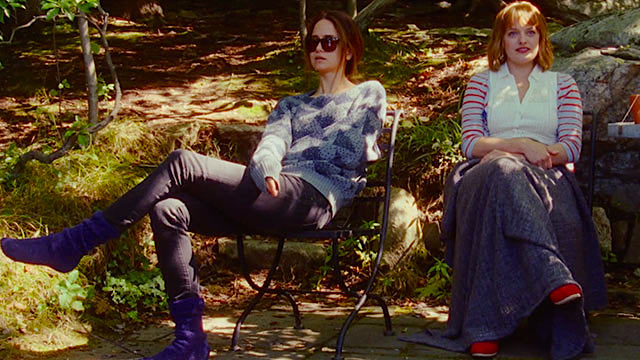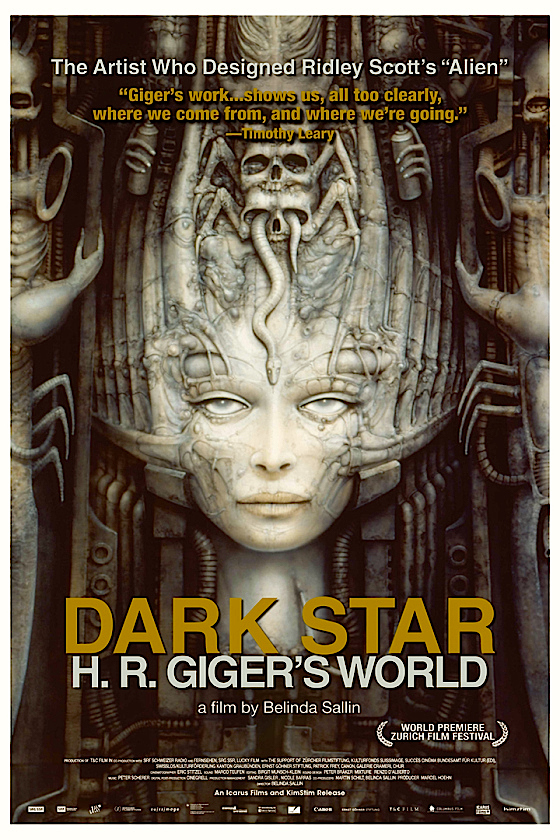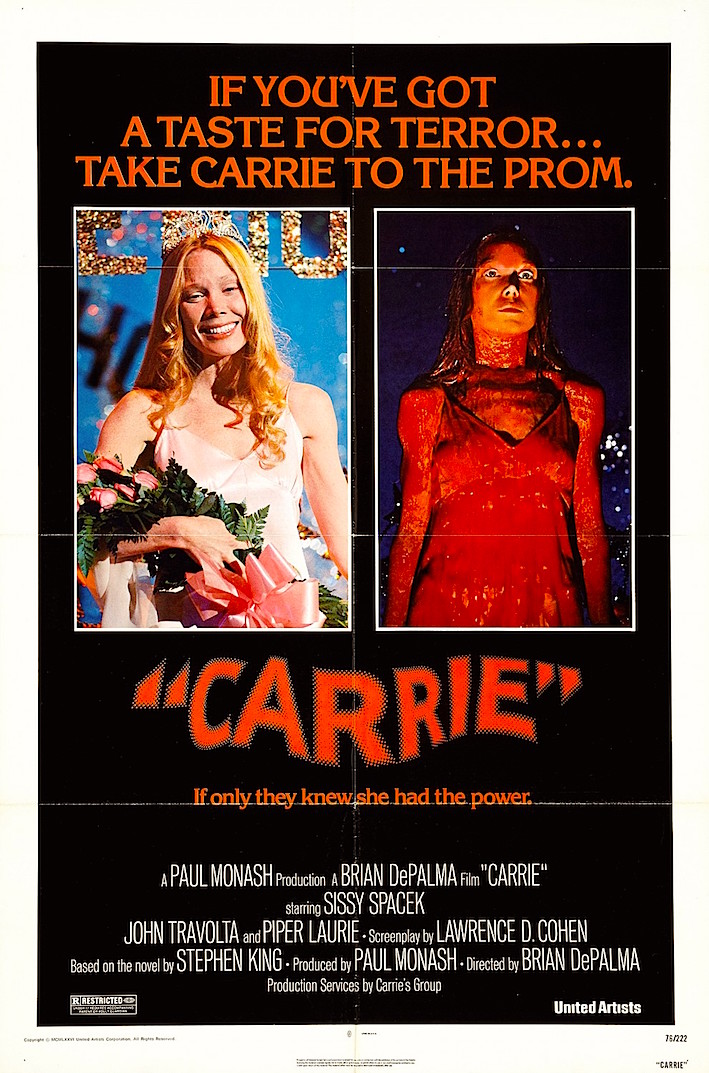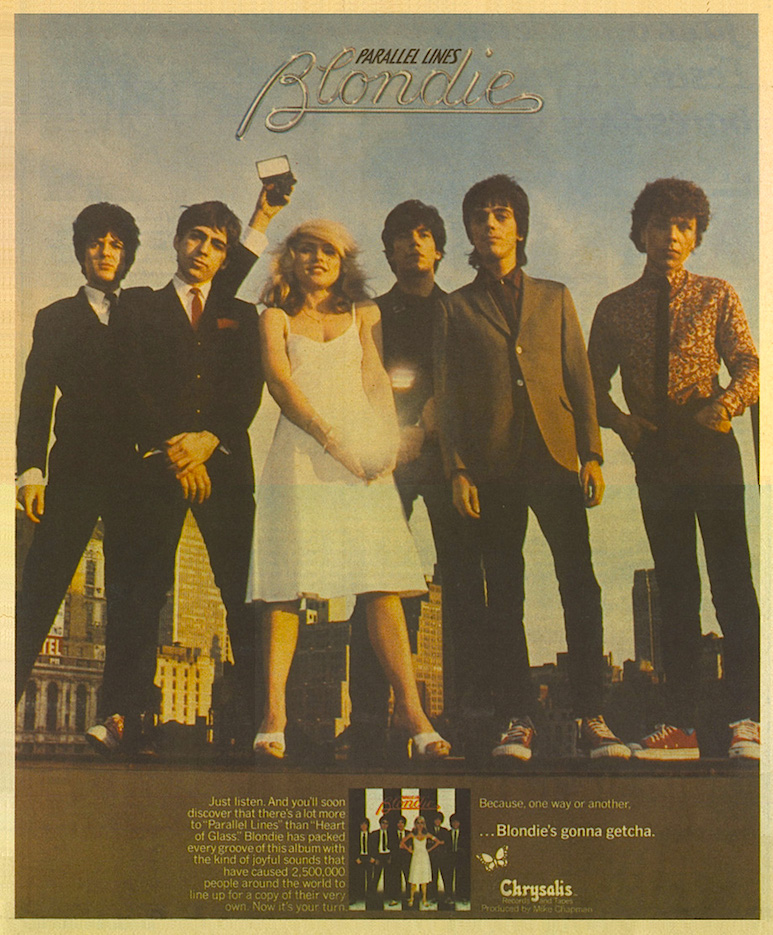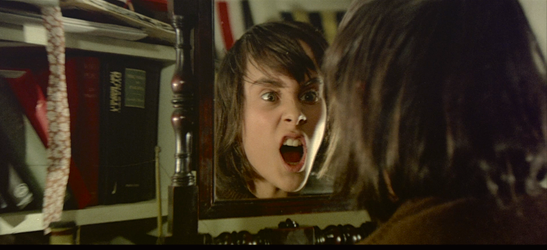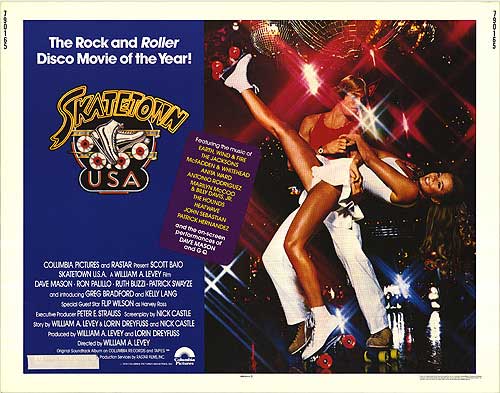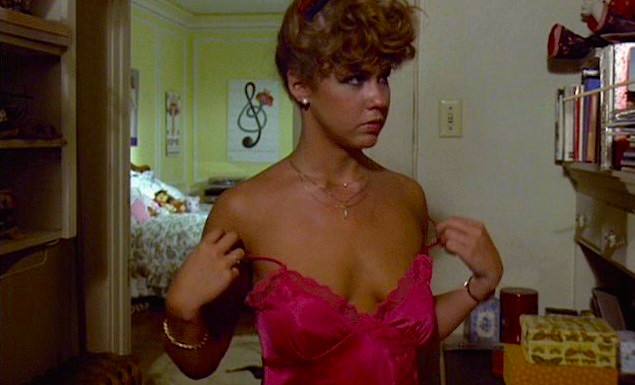Cinematic Motivation is never more clear than when a film artist decides to create a personal adaptation of another’s work. Often the source material serves as a clearly stated guidebook for the film it inspires.

“Come on! Let’s go.”
Isabelle Huppert / Sandrine Bonnaire
La Ceremonie
Claude Chabrol, 1996
Cinematography |
Bernard Zitzermann
However, when one is dealing with an articulate and strong-willed film artist, an adaptation will serve as a point from which the filmmaker can jump into aspects of the source that is either hidden with the corners of plot or that is sometimes simply not there. This is most definitely true of two films based on well-established and respected source materials.
In 1996, Claude Chabrol opted to translate a highly respected crime novel for the Big Screen. Fourteen years later a younger South Korean filmmaker, Sang-soo Im, who had studied to become a Sociologist, would decide to “remake” a classic 1960 Korean horror film.

Domestic Horror Taken to a Whole New Level. This is a key classic Korean film. A warped horror film that remains shocking 55 years later.
Kim Jin-kyu / Lee Eun-shim
The Housemaid / Hanyeo
Kim Ki-young, 1960
Cinematography | Kim Deok-jin
Both of these filmmakers chose particularly well-known works. While it is clear that they both respected the works from which they would create two important modern films — neither had a problem with subverting core ideas to their respective cinematic intentions.
The Iconic co-founder of La Nouvelle Vague, Chabrol was not a sociologist but he was an astutely politically aware artist. Chabrol refused to label his work as “political” but it was. A self-proclaimed Communist, he did not live the life of a Communist, but he was often concerned with the plight of the struggling classes within French society. As the economic gap between the wealthy and the impoverished, one can see his societal frustration emerge in most of his films.

Friends or Conspirators?
Sandrine Bonnaire / Isabelle Huppert
La Ceremonie
Claude Chabrol, 1996
Cinematography | Bernard Zitzermann
Chabrol was far less interested in plot as he was in the characters and their often odd choices and actions within the plot. This is not to say that plot was not important to Claude Chabrol. It was. But his plots are often pushed to the side of the screen so that the audience focuses on the ideas and the actions of the characters. Chabrol seemed to see very little use in explaining the nature of humanity. The actions and choices of his characters carry consequences and often push or pull the plots in various directions and shapes.
Sang-soo Im didn’t not pursue a life as a Sociologist, but he fully understands sociology and the rigid restrictions that exist between and among the ever-mounting class struggle of South Korea. Like Chabrol, he is normally focused on the way elitist concerns are forcing the working classes and impoverished further down the Korean societal ladder.

A the South Korean Economic Gap Between Wealth and Poverty Grows, a woman plunges to her death. The opening sequence of
The Housemaid / Hanyeo
Sang-soo Im, 2010
Cinematography | Lee Hyung-deok
His films serve as often controversial commentary regarding his country’s leadership and the power that money play out in removing access to control personal choices and opportunities. Plot is more important to Im, but his characters’ motivations are often more required than chosen. For many of Sang-soo Im’s characters, there are no choices — only actions.
Ruth Rendell’s British crime novel, A Judgement in Stone, was published to great acclaim and success in 1977. This novel is best known for delivering the following blunt statement as it’s first sentence:
“Eunice Parchman killed the Coverdale family because she could not read or write.”
Wham! And Rendell’s novel begins. Chabrol loved the novel, but he was not willing to limit the main character’s motivation strictly to illiteracy. It most certainly seems to factor into her choice, but it never feels like the chief motivation. This should not surprise anyone familiar with Chabrol. Chabrol has never been interested in motivation of his characters. They are human. When it comes down to it, can we really ever fully understand why someone does something?

Pushed down by their class or pulled down by personal struggles that have been ignored?
La Ceremonie
Sandrine Bonnaire / Isabelle Huppert
Claude Chabrol, 1996
Cinematography | Bernard Zitzermann
A character he renamed, “Sophie Bonhomme” is played expertly by Sandrine Bonnaire. Unlike Rendell’s classic novel, we do not know that Sophie is illiterate immediately. We are also not ever completely sure why she is unable to read or write. We do pick up that she comes from a lower class background and that she spent a good deal of her young life caring for her ailing father. Perhaps education was not an option. Or, maybe, Sophie simply has learning limitations with which assistance was not available. Not being able to read or write is clearly a source of great anxiety and frustration, it never feels as if it is the most challenging aspect of her situation. There seems to be something far more worrying at Sophie’s core

Reflection of doubt, self-loathing, frustration or a sociopathic rage?
Sandrine Bonnaire
La Ceremonie
Claude Chabrol, 1996
Cinematography | Bernard Zitzermann
In Kim Ki-young 1960’s The Housemaid, we follow the story of a composer and his pregnant wife who decide that they need to hire a maid to assist with the running of the household. What makes this old film so potent is it’s unhinged approach to horror. The newly hired housemaid is trouble. The film is surprisingly graphic and strange for it’s era. The Housemaid systematically engulfs the entire family into a state of domestic horror. Clearly insane, this maid spys, enjoys subversive behavior and prefers to catch/kill rodents with her own hands rather than rely on poison or traps. She thinks nothing of seducing the husband. But when she becomes pregnant she panics. The composer’s wife begs her to abort the baby by self-harm. She does, but then the crazy-bat-shit really hits the fan. The housemaid becomes a full blown menace who has no problem with evil tricks, torture and murder. Even children are not spared her cruelty.
Sang-soo Im basically throws this entire plot out of the window. His 2010’s The Housemaid is not a horror film as much as it is an erotic thriller. However, “thriller” is not an altogether correct label for this “remake.” Sang-soo Im has created an entirely different film. Essentially, it only shares the same title.

Caring for their little girl and cleaning house are not the only “chores” which quickly become more and more degrading… Welcome to Sang-soo Im’s “Erotic Thriller”
The Housemaid / Hanyeo
Jeon Do-yeon / Lee Jung-jae
Sang-soo Im, 2010
Cinematography | Lee Hyung-deok
This is the story of the poor soul hired by a cruel wealthy family. This family uses “politeness” with their servants as a device rather than a courtesy and any level of respect is nonexistant. The hired help are far below them. They exist only to serve and have little to no human value. And, in Im’s film the housemaid, Eun-yi, is not alone. She has an additional key duty and boss. She has been hired as both an Au Pair to the young couple’s daughter and as an assistant maid. Besides the husband and pregnant wife, she also reports to Miss Cho. Do-yeon Jeon plays Eun-yi and the great Yuh-jung Youn plays Miss Cho. Both performances are effortlessly realistic. When these two women are on the screen you almost forget you’re watching a movie.

The Head Maid understands that to survive in the world of servant to a wealthy family one has to transform into a cold stone or face whatever added humiliation their masters plan to deliver.
Youn Yuh-jung
The Housemaid / Hanyeo
Sang-soo Im, 2010
Cinematography | Lee Hyung-deok
Miss Cho knows the score, but is a strict boss. Nothing happens in this sleek minimalist home without her knowing. Constantly poking the newly hired Housemaid / Au Pair to do everything with perfection, it is hard for the audience to know if Miss Cho is friend or foe. It is not until the mid-point of the film, while she is attempting to relax in the servant’s bathtub she explains to Eun-yi why she is so hard on her:
“You get up in the morning and think of what you have to endure. And, damn. It makes your gut hurt. But what can you do? Just breathe in deep and transform into a cold stone.”

Daughter and Mother or Conspirators? The Mistresses of the house know no limit to their cruelty.
Seo Woo / Park Ji-Young
The Housemaid / Hanyeo
Sang-soo Im, 2010
Cinematography | Lee Hyung-deok
At this point we realize that Miss Cho has been trying to teach Eun-yi to be precise and hard so as not to become any more a victim of this family than she already has to be.
We already know what Sang-soo Im has in mind. He begins the film in the tourist area of Seoul where the lower classes sweat and struggle to serve and clean-up after the tourists and middle class Korean party animals. Eun-yi is one of the working slaves. She sees a young women recently tied to scandal and ruin toss herself from a building. The tourists are shocked, but this serves as more of a curiosity and nuisance to the workers. Eun-yi, however, is shaken to the core.

Cleaning to please and entice…
Jeon Do-yeon
The Housemaid / Hanyeo
Sang-soo Im, 2010
Cinematography | Lee Hyung-deok
Taking on a job as an Au Pair / Housemaid is a welcome change. She will be given her own room and will share her bathroom with only Miss Cho. At first it seems like a dream job. Her dream will quickly transform into a nightmare far harder than any cold stone.
Back in the lush but secluded mansion in Brittany, Sophie is struggling. While the family is polite and even kind, both the wife and husband seem to have an-ongoing debate whether or not they should “teach” the new maid how to do things exactly the way they like them done. The husband, Jean-Pierre Cassel, appears constantly unsatisfied about one thing or another. The wife, expertly played by Jacqueline Bissett, does not seem to disagree as much as she is hesitant to address what are most likely only minor issues that will work themselves out. Valentin Merlet plays their young teenage son who is seemingly amused by the situation. Their young adult daughter, Virginie Ledoyen, is the voice of concern for Sophie. She seems idealistic in her attitude toward the family’s “need” of a live-in maid, but there are numerous hints that this attitude is largely derived from a collegic life and is a passive-aggressive way to prod her father and step-mother.

Well-intentioned on the surface, but this wealthy family seems to struggle with their own level of self-entitlement. Their concerns and politeness seem to be more about “political correctness” than any ethical sense.
Virginie Ledoyen / Valentin Merlet / Jacqueline Bisset / Jean-Pierre Cassel
La Ceremonie
Claude Chabrol, 1996
Cinematography | Bernard Zitzermann
The truth is the Lelievre family appears to be fairly normal in their attitude toward their maid. There is a strong element of wealth-guilt within the wife’s interactions, the husband seems over-worked and uses humor to tinge his issues. The son and daughter are both normal children of upper-class privilege. No one in this family is cruel. And most certainly, there is no clear intent to be cruel. This, of course, is Chabrol’s clever way of making the audience squirm. It is hard not to like this family, but as the film moves forward — it becomes challenging to not be annoyed by their unintended treatment of Sophie as inferior and casual disregard for her personal time.
The wife begins to leave notes and lists of tasks she needs Sophie to perform. It is here we know that Sophie is unable to read or write. She clutches the note and runs to her small room where she keeps a child text on phonetics. She struggles to fit the letters and words to the codes in the book. Bernard Zitzermann’s cinematography gradually shifts into warped close-ups which add further distortion to the faces of the characters as they grimace, worry or think. It is an effectively disorienting effect that is not immediately noticed.

No educational assistance, illiterate, misfit or insane. Sophie’s frustration is beginning to form into rage.
Sandrine Bonnaire
La Ceremonie
Claude Chabrol, 1996
Cinematography | Bernard Zitzermann
As Sophie becomes frustrated, the camera moves in just a bit closer. Finally as she reaches her limit of frustration she begins to find clever but increasingly challenging ways to have the notes read to her so that no one will notice she is unable to read.
Eventually she turns to the one person outside of the family who she has met, Jeanne. Enter Claude Chabrol’s longtime favorite muse, Isabelle Huppert. As with all of her roles, Huppert doesn’t merely play her character — she seems to slip into Jeanne’s skin. Jeanne initially appears to be an eccentric and harmless townie who enjoys gossip and flops about as if she were a child. Jeanne and Sophie start to bond after she assists with one of the notes. It isn’t clear if Jeanne understands that her new friend is illiterate. What is clear is that she wouldn’t care either way. She appears happy to have made a friend. She is even more excited to have made a friend that gains her access to the Lelievre family home. Jeanne appears to have more than a few problems with the Lelievre family. She holds them in disdain. From Jeanne’s perspective, this is a family of fraudulent snobs.

The Scandalous Postal Employee: Child Killer or Mentally-Challenged Misfit?
Isabelle Huppert takes a puff
La Ceremonie
Claude Chabrol, 1996
Cinematography | Bernard Zitzermann
As a postal employee she enjoys peeping into other’s mail. A habit that rightly infuriated Mr. Lelievre. Much like we quickly come to understand about Mr. L he doesn’t care for dealing with issues in appropriate ways. He marches into the post office and accuses Jeanne. Playing innocent, Jeanne provokes his anger to higher level. She pushes every button she can find until Mr. L slaps her. Most likely a very bad choice of action. It isn’t long before The Lelievres decide to inform Sophie that they do not approve of her friendship. She is then advised that she is “free to be friends” with her (as if it is their choice) but she is “not allowed” to have Jeanne over for tea and watch TV in her private room — which seems like an antiquated sort of former servants’ room. This pronouncement seems to push Sophie to a whole new level of frustration. And yet, in a classic move by Chabrol, Sandrine Bonnaire holds back. We are never quite sure of what she thinks or feels.
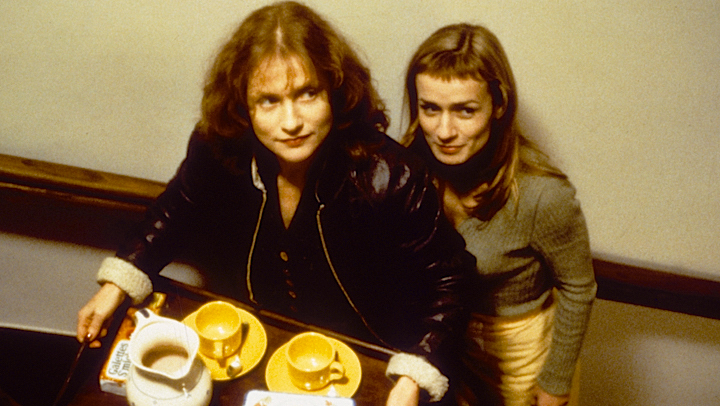
A bit of fun or anarchy? Isabelle Huppert / Sandrine Bonnaire
La Ceremonie
Claude Chabrol, 1996
Cinematography | Bernard Zitzermann
Later Zitzermann’s camera starts to move in to slowly distort Bisset’s face as she regains her composure to return to the small party the family is holding. This distortion serves as a sort of signal that Mrs. L is losing her patience with her maid.
Back in South Korea, the newly hired servant is having some issues of her own. On a short family “holiday” the family and Eun-yi Li take off for the summer cottage in the winter. While the husband, wife and daughter sit in the warm hot tub, the Au Pair/ Housemaid is left sitting just outside in the cold. When the cute little girl, Nami, decides she wants to jump into the cold pool — Eun-yi tosses off her towel and jumps into the cold pool with her. The child then returns to the warmth. Eun-yi remains wet and in the cold. Even still, she doesn’t seem to mind.
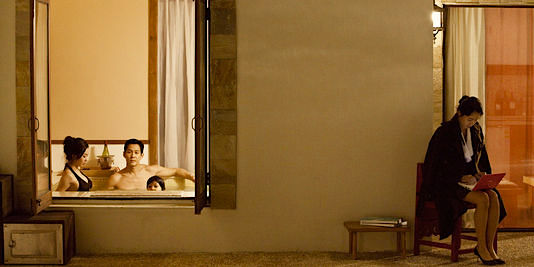
The family relaxes in the warmth while their housemaid sits patiently in the cold.
Jeon Do-yeon as
The Housemaid / Hanyeo
Sang-soo Im, 2010
Cinematography | Lee Hyung-deok
Later than evening after a disappointing attempt at sex with his very pregnant wife, the husband decides to pay his new housemaid a visit. As she hears footsteps, Eun-yi quickly puts her sweat shirt on. Before she has a chance to gather her thoughts the husband is making his moves. He insist that she have a sip of wine. Then he quietly says, “Let me have a look.” — he pulls the cover off the housemaid and proceeds to touch her body in a sensual tease. Clearly uncomfortable and confused, it is hard to tell if Eun-yi is upset or aroused. It doesn’t really matter. It is clear the husband isn’t going to take no for an answer even if she chose to demand it.

Would you like to suck your master’s wine bottle? Does she really have a choice?
Jeon Do-yeon / Lee Jung-jae
The Housemaid / Hanyeo
Sang-soo Im, 2010
Cinematography | Lee Hyung-deok
She submits and seems to welcome his touch and sex. Sang-soo Im is not afraid of eroticism. The two actors encage in a highly erotic sex scene. Despite the eroticism, there is an ever-present uncomfortableness about the scene. This is not implied. It is there. Be it a good idea or a bad one, this servant is willing to indulge her master. As she kisses his nude body, the husband takes on the role of “Sex God.”

A Questionable Seduction as The Servant “services” The Master… Erotica pushed to the limits of an R-Rating
Jeon Do-yeon / Lee Jung-jae
The Housemaid / Hanyeo
Sang-soo Im, 2010
Cinematography | Lee Hyung-deok
Clearly, he is more turned on by the adoration than by the woman. He flexes his muscles, drinks his wine and proceeds to have his way with “the help.” Their affair continues. The housemaid begins to fall in love with this self-absorbed man.

Master lost in his own fantasy. Master and Servant
Lee Jung-jae
The Housemaid
Sang-soo Im, 2010
Cinematography | Lee Hyung-Deok
She also finds herself growing attached and devoted to the child, Nami. Eun-yi reads a particularly disturbing fairy tale to Nami. Despite the gruesome story, the Au Pair expresses her feelings to the child:
“I love how you are such a good child. You’re not bad-tempered. You’re polite to me.”
Nami answers with the sort of honesty that only a child can provide, “Daddy taught me to be polite. It may seem like a sign of respect, but it’s really putting myself first.”
It is here we are once again reminded that Eun-yi’s experience of the world is limited. She does not think with duplicity, but there is a slight hesitation as she takes in the meaning of what this innocent child is telling her. Miss Cho understands this better than anyone: this family has no respect for anyone other than the people of wealth with whom they share the world’s glory.
Miss Cho continually attempts to both advise and warn Eun-yi that she is still young and desirable. She should leave this “Hell,” find a man and marry. Better to be poor with someone you love than to serve this “scary people.” In a moment of brutal honesty she informs the Au Pair/housemaid that “This job is R.U.N.S. Revolting, ugly, nauseating and shameless. I have wasted my whole life in this place.”

The servant hired to mother the wealthy child who offers politeness as a means of putting her own interests first.
The Housemaid / Hanyeo
Sang-soo Im, 2010
Cinematography | Lee Hyung-deok
Unlike Miss Cho, Eun-yi is unable to transform into a cold stone. Eventually this family pushes the young woman to the point of no return. She is meaningless to them. To the man she thought she loved, she is simply flesh with three holes for his pleasure. She is the object of bullying, intimidation and suffers a far greater indignity that seems to drain her of all hope.
“I am going to get revenge. However small, I have to do something.”
One gets the feeling that Miss Cho sees no way for this young woman to seek out vengeance on such a powerful family. This is prominent family who are firmly placed within the class structure of South Korea. And this family’s world is built on corruption and cruelty that seems to fit easily in a culture and society that is increasingly limited to the “have nots.” But Miss Cho does have some power. The young wife has had her twins. The family needs assistance like never before. Miss Cho quits and tosses part of her uniform on the metallic floor. Outraged, the husband demands, “What do you think you are doing?!?!” Miss Cho looks at him and almost trembling in rage answers, “What the hell are doing? You really like living like this?!?”
The quiet daughter, Nami, looks on with a concerned face.
The husband dismiss Miss Cho’s actions, “This is what these people are like. Just ignore her.”
The powerful feel safe in their cocoon. No one can hurt them. Most especially the common servants. He is wrong. Eun-yi gets her vengeance. It is twisted and horrifying. Sang-soo Im turns the tables on the vile family and on his audience. Nothing quite compares the viewer for what comes next.

Look what you made me do.
Jeon Do-yeon
The Housemaid / Hanyeo
Sang-soo Im, 2010
Cinematography | Lee Hyung-deok
Back in France, Sophie and Jeanne finally fully bond over a lunch of freshly picked wild mushrooms and stale wine. As they eat and chat, Chabrol finally allows us some insight into this marginalized women. It is almost shocking when Sophie casually informs Jeanne that she has heard something about her. Jeanne pauses and indicates that she has learned something good. With a slight smile on her face, Sophie tells her that she knows Jeanne killed her own daughter. The response is equally odd. Unbothered, Jeanne calmly states:
“It’s not true. It was her own fault. Anyway, they couldn’t prove it. Want to see a picture?”
Within a few minutes we discover that Sophie murdered her ailing father and then set fire to their home which had just been taken from them to develop luxury condos. Realizing that they are both murderers, they start to giggle like two school girls. What makes this scene so chilling is it’s simplicity. Sophie had grown weary of caring for her father and the one thing she had was taken to make way for luxury living quarters that she would never be able to afford. So she killed her father and burned their humble home to the ground. Jeanne was a single mother unable to support a child. Whether or not the murder was intended is not clear, but there is no remorse. Life is easier without another mouth to feed and the demands of motherhood.
The family dismisses Sophie. She pushes them into a corner. They have no choice. She should be fired. But the head of the house terminates her like a angry man scolding a dog. Essentially, he will allow her some shelter and food for a short while until she finds new employment. Sophie is left to stew in what is clearly a sociopathic mind. As the family gathers to watch the live televised airing of an opera, there is a brief conversation. The family is relieved that they have done the right thing by firing their maid. The problem is that they have told her she can stay on for two weeks until she finds a place to live. Mr. L is cruel in his dismissal. The cruelty is completely understandable, but he has not thought about the anger that is seething just beneath the surface of Sophie’s calm exterior. This is their home. They are safe. No one could ever hurt them. Most certainly not some illiterate common maid. Everyone calm and secure, they settle down to watch the opera.

No time to worry about the help, it’s time to enjoy the televised opera.
Jacqueline Bisset / Virginie Ledoyen / Jean-Pierre Cassel
La Ceremonie
Claude Chabrol, 1996
Cinematography | Bernard Zitzermann
Sadly, the peasants are outraged and demented. Sophie has secretly let Jeanne into the Lelievre home. The two angry women joke about the vile “bastards” siting in the library with all their fancy books, antiques, television and watching some bourgeoisie opera. And then, Jeanne discovers something in a small room just off from the kitchen: The Lelievre shotgun collection.
Before long Sophie and Jeanne are playing around in the kitchen with the guns. The family hears something. The son suspects that the “weirdo from the postal office” is in the kitchen. Mr. L gets up to send them both out but for good. Only the wife is hesitant. Maybe it’s better to leave it alone. But all three disagree. Mr. L makes his way to the kitchen.
Like The Housemaid, these two marginalized and angry women have come to a tipping point. Their “vengeance” is really more of a “judgement.” From the warped perspectives of two people who have been pushed or pulled down all of their lives, they only know a few ways to deal with their anger at a society that rejects them. Typical of the great Chabrol, the carnage that follows is delivered realistically and without any of the normal cinematic tropes the filmmakers often use when filming this sort of horror. Zitzermann’s camera follows. There are no editing tricks. There is no foreboding musical score. Even though we know what is coming, nothing quite prepares us for it.
As these two masterful, entertaining and disturbing films come to their close the viewer is left with several realizations. Perhaps the most important is the reminder that revolt or revolution is never an actual solution, but when one or two take place the impact is devastating and cruel. Neither Chabrol or Im are particularly clear at the close of their films.
In Chabrol’s universe, Sophie and Jeanne have committed horrible acts.

The Servants’ Revolt
Sandrine Bonnaire / Isabelle Huppert
La Ceremonie
Claude Chabrol, 1996
Cinematography |
Bernard Zitzermann
However, one cannot help but wonder if this all could have been avoided. Why didn’t this community do more to assist this once desperate and struggling mother? Why hasn’t her minister and church attempted to offer her guidance? Instead a judge simply dismisses her and her action. Her church and minister find her crude and childish. They no longer want her help in their charity work or even want her at their church. Sophie is clearly struggling with the solitary life in Brittany, yet the family continually alternates between “hot” and “cold” in their interactions with the maid. They do offer assistance, but it all seems to come with pressure and sideways logic. This is a good family, but they prefer to stay within the confines of this cocoon reserved for the wealthy. They fully realize that they are lucky, but they never think beyond that point. It is as if they have developed a false sense of safety.
In Sang-soo Im’s universe the societal structure of South Korea has become so fractured between the wealthy and impoverished that there is almost a complete disconnect. As he brings this class struggle down to a contained plot of a newly hired maid, we see the plight of the workers being exploited by those to whom they serve. This family is evil. Only their young daughter seems to offer any hope for their redemption. Nami seems to see her world realistically. Her Au Pair has also given her a traumatic experience that will no doubt take form in some way. Which way is not entirely clear.
Unlike Chabrol, Im prefers to leave his audience with a strange and disturbing bit of Surrealism. The family is gathered outside of the mansion in the cold. It is Nami’s birthday. As her drunken parents wish her a happy day and tell her that the world is hers, Nami simply watches them and then walks slowly toward us in an ever increasing sort of fishbowl lens. The Housemaid had told her she was sorry and that she should never forget her. While it is unclear about the future of the world in the hands of Nami, one thing is certain. Nami will not forget The Housemaid. Neither will we.

The future is hers. How will she form or play within it?
The Housemaid / Hanyeo
Sang-soo Im, 2010
Cinematography | Lee Hyung-deok
I last I hope we don’t. As the economic gap shows no sign of diminishing, it is important we take the time to re-evaluate the way we interact with others. And as racism has not been this ugly in decades, we better take a long hard look at how we allow our politicians to move forward. We are living in extreme times. It is time to “re-think” motivations, intentions and the way we respond.
Matty Stanfield, 9.1.2015









